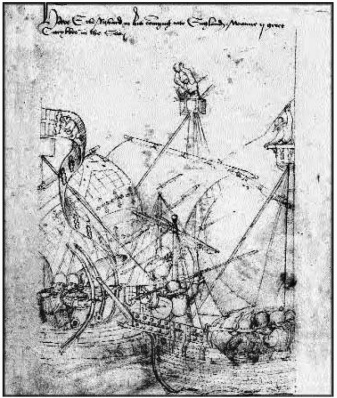A battle at sea from the Warwick pageant, produced at the end of the fifteenth century. Cannon as well as bowmen can be seen on the ship on the left.
Fought on 15 August 1416 in the mouth of the Seine Estuary near HARFLEUR, the Battle of the Seine was one of the largest naval encounters of the war. The English victory broke the French blockade of Harfleur and helped HENRY V achieve mastery of the seas, a necessary prelude to the conquest of NORMANDY.
Although Henry sought to make Harfleur as secure a base as CALAIS, the cross-Channel distance to the former was four times that of the latter and maintaining local control of the seas proved beyond the abilities of English naval power. Despite his victories in the battles of VALMONT in March, Thomas BEAUFORT, earl of Dorset and commander of the Harfleur garrison, was in a desperate position by late spring. Blockaded by land and sea, Dorset wrote pleading letters to England describing the privations of his men. Deeply engaged in the discussions that led to conclusion of the Treaty of CANTERBURY with Sigismund, the Holy Roman emperor, Henry deputed the relief of Harfleur to his brother, JOHN, DUKE OF BEDFORD.
Bedford spent the early summer collecting ships and seamen at Southampton and Winchelsea and by early August had a fleet of perhaps a hundred vessels. After overcoming logistical delays and foul winds that allowed the enemy to harry the English coast, Bedford set sail on 14 August with a fair wind that put him in the Seine Estuary by nightfall. Dawn revealed a French fleet of perhaps 150 ships commanded by Guillaume de Montenay anchored in midstream before Harfleur. Besides numbers, the French had the advantage of possessing eight Genoese carracks, which were larger, higher, and more powerful than anything in the English fleet. The Genoese were the best sailors in Europe, and from the higher decks of their warships could rain missiles of all kinds down upon the English. However, with the French in an irregular massed formation, Bedford bore down on them at full sail, and the sandbars and close quarters of the estuary allowed the maneuverability of the smaller English vessels to outweigh the mass and height of the Genoese ships. With the element of luck also playing a part, the English prevailed after a long fight—the sources say seven hours—capturing three Genoese carracks and driving another aground. CASUALTIES were heavy in both fleets, with the English losing some twenty ships and their crews.
With the enemy fleet dispersed, half the remaining English ships made for Harfleur and the relief of the starving garrison, while the rest conveyed Bedford, who was wounded during the fight, back to England. Upon hearing of the victory, Henry, having that day concluded his treaty with Sigismund, rode with his new ally to Canterbury Cathedral to hear Te Deum sung.
Further Reading:
Allmand, Christopher. Henry V. New Haven, CT: Yale University Press, 1997; Burne, Alfred H. The Agincourt War. Ware, England: Wordsworth Editions Ltd., 1999.
